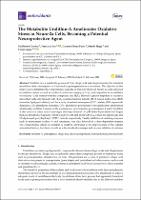Por favor, use este identificador para citar o enlazar este ítem:
https://repositorio.usj.es/handle/123456789/381
Registro completo de metadatos
| Campo DC | Valor | Lengua/Idioma |
|---|---|---|
| dc.contributor.author | Cásedas, Guillermo | - |
| dc.contributor.author | Les, Francisco | - |
| dc.contributor.author | López Ramos, Víctor | - |
| dc.contributor.author | Choya-Foces, Carmen | - |
| dc.contributor.author | Hugo, Martín | - |
| dc.date.accessioned | 2020-04-29T07:15:44Z | - |
| dc.date.available | 2020-04-29T07:15:44Z | - |
| dc.date.issued | 2020-02-21 | - |
| dc.identifier.citation | Cásedas, G.; Les, F.; Choya-Foces, C.; Hugo, M.; López, V. The Metabolite Urolithin-A Ameliorates Oxidative Stress in Neuro-2a Cells, Becoming a Potential Neuroprotective Agent. Antioxidants 2020, 9, 177. | es_ES |
| dc.identifier.issn | 2076-3921 | es_ES |
| dc.identifier.uri | https://repositorio.usj.es/handle/123456789/381 | - |
| dc.description | Urolithin A is a metabolite generated from ellagic acid and ellagitannins by the intestinal microbiota after consumption of fruits such as pomegranates or strawberries. The objective of this study was to determine the cytoprotective capacity of this polyphenol in Neuro-2a cells subjected to oxidative stress, as well as its direct radical scavenging activity and properties as an inhibitor of oxidases. Cells treated with this compound and H2O2 showed a greater response to oxidative stress than cells only treated with H2O2, as mitochondrial activity (MTT assay), redox state (ROS formation, lipid peroxidation), and the activity of antioxidant enzymes (CAT: catalase, SOD: superoxide dismutase, GR: glutathione reductase, GPx: glutathione peroxidase) were significantly ameliorated; additionally, urolithin A enhanced the expression of cytoprotective peroxiredoxins 1 and 3. Urolithin A also acted as a direct radical scavenger, showing values of 13.2 µM Trolox Equivalents for Oxygen Radical Absorbance Capacity (ORAC) and 5.01 µM and 152.66 µM IC50 values for superoxide and 2,2-diphenyss1-picrylhydrazyl (DPPH) radicals, respectively. Finally, inhibition of oxidizing enzymes, such as monoamine oxidase A and tyrosinase, was also detected in a dose-dependent manner. The cytoprotective effects of urolithin A could be attributed to the improvement of the cellular antioxidant battery, but also to its role as a direct radical scavenger and enzyme inhibitor of oxidases. | es_ES |
| dc.format.extent | 16 p. | es_ES |
| dc.format.mimetype | application/pdf | es_ES |
| dc.language.iso | eng | es_ES |
| dc.publisher | MDPI AG | es_ES |
| dc.relation | This work has been partially financed by Universidad San Jorge and by Spanish Government grants (RTI 2018-094203-B-I00 to A.M.R and IJCI-2017-34170 to M.H.). | es_ES |
| dc.rights | Atribución 4.0 Internacional | * |
| dc.rights.uri | http://creativecommons.org/licenses/by/4.0/ | * |
| dc.subject | Urolitina A | es_ES |
| dc.subject | Ácido elágico | es_ES |
| dc.subject | Polifenoles dietéticos | es_ES |
| dc.subject | Neuroprotección | es_ES |
| dc.subject | Peroxiredoxinas | es_ES |
| dc.title | The metabolite urolithin-a ameliorates oxidative stress in neuro-2a cells, becoming a potential neuroprotective agent | es_ES |
| dc.type | info:eu-repo/semantics/article | es_ES |
| dc.subject.unesco | Célula | es_ES |
| dc.identifier.doi | https://doi.org/10.3390/antiox9020177 | es_ES |
| dc.rights.accessrights | info:eu-repo/semantics/openAccess | es_ES |
| Aparece en las colecciones: | Artículos de revistas | |
Ficheros en este ítem:
| Fichero | Descripción | Tamaño | Formato | |
|---|---|---|---|---|
| The metabolite urolithin-a ameliorates oxidative stress in neuro-2a cells, becoming a potential neuroprotective agent.pdf | 2,06 MB | Adobe PDF |  Visualizar/Abrir |
Este ítem está sujeto a una licencia Creative Commons Licencia Creative Commons

